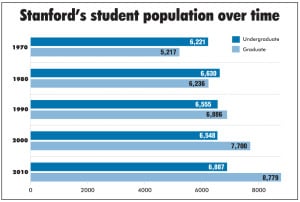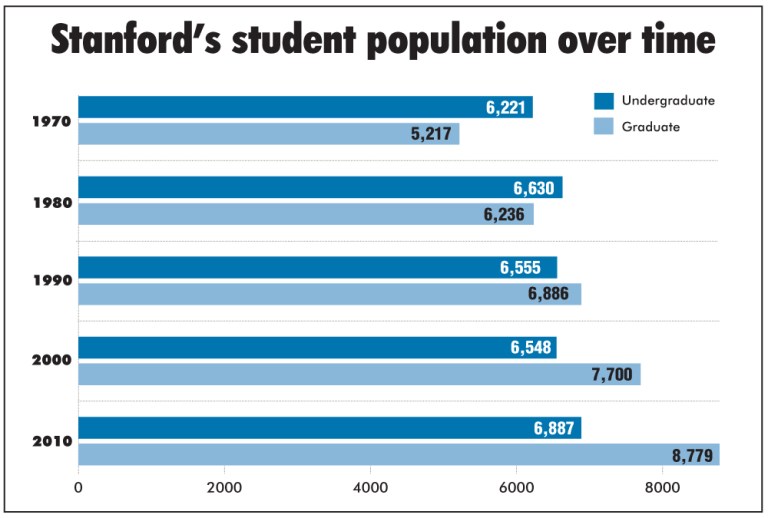At his annual presentation to the Academic Council last month, President John Hennessy announced a plan to expand the undergraduate student body in an attempt to keep pace with the growth of the graduate student population and allow Stanford to serve more students, a proposal with broad implications for University admissions, facilities and faculty.

The large size of the graduate student population—8,871 students compared to 6,999 undergraduates—marks a sharp reversal from the enrollment trends that have dominated much of Stanford’s history.
In every decade until 1990, the undergraduate population exceeded the graduate one. The gap narrowed by 1980, when the student body was about evenly split. Since then, the graduate population has continued to grow rapidly while the number of undergraduates has remained relatively constant.
Jeffrey Wachtel ’79, senior assistant to President Hennessy, noted that Hennessy sees several benefits in attempting to expand the undergraduate population and believes the expansion can be accomplished without “sacrificing the quality of the undergraduate experience.”
“We want to retain our identity as both an undergraduate and a graduate institution,” Wachtel said. “Although the numbers are relatively small that we can add, we think it’s sort of an obligation for the University.”
Hennessy said that he would like the undergraduate population to expand soon to counteract the growth of the graduate and postdoctoral populations over the last few decades.
“If we assume that there’s going to be some continuing growth in the graduate population, perhaps at a slower rate, then we will, over the next 20 years or so, completely make it impossible to contemplate increasing the undergraduate population, because the grad population will have taken up all the space on campus,” Hennessy said.
More housing
Though the expansion could begin as early as 2014, according to Wachtel, the growth in the population would also need to be accompanied by new facilities to maintain the University’s guarantee of housing to all undergraduates. The University, fresh off a Draw that left a record number of students unassigned after the first round, already plans to build new housing at Manzanita Park and Lagunita Court.
“Since we believe strongly in a residential education system, we have to make sure there are adequate housing and facilities,” Wachtel said. “It depends on the planning of the housing and raising the money for it.”
Once housing options are adjusted, Wachtel said that the University will begin increasing the size of the undergraduate population by approximately 100 students per year, with a plan to reevaluate the rate of expansion over time.
According to Hennessy, the upper bound on the population expansion would be 25 percent, as growth that is too dramatic could alter the undergraduate experience.
“Everybody has that sense that at some size the experience would change in a qualitative way, but nobody knows what that size is. If we had 16,000 [students], it would be very different to be an undergraduate on campus,” he said. “That’s far beyond what we’re thinking—but the nice thing of doing this gradually is that you can get some sense of what’s changing.”
Role of admissions
University officials noted that it is easier to target a specific number of admits for the undergraduate population compared to graduates, as the nature of graduate admissions makes it difficult to systematically increase or decrease the number of students admitted each year.
“Admissions at the graduate level is very decentralized to departments,” said Vice Provost for Graduate Education Patricia Gumport M.A. ’82 M.A. ’86 Ph.D. ’87. “At the undergraduate level, it’s very centralized—there’s one admissions office. So that’s why the enrollment can be managed at the undergrad level.”
While undergraduate enrollment has remained fairly constant over the last three decades, the number of applications received by the Office of Undergraduate Admission has skyrocketed.
Hennessy cited this increase in applications as a key reason behind the decision to expand the undergraduate population, estimating that the number of highly qualified applicants has roughly doubled during his tenure.
“The acceptance rate has plummeted,” Hennessy said. “A general sense that the number of students who are prepared to do work at a place like Stanford has grown significantly is reflected in our application pool.”
According to Hennessy, the University had previously planned to begin offering more spots to these applicants, but the 2008 financial crisis set back the idea. The gradual recovery of the endowment has prompted a renewed focus on expansion.
“For many years, growth was accommodated by the public institutions, namely the [University of California schools], but given the state dilemma over finances I don’t think we’re going to see tremendous expansion of the state system,” Hennessy said. “So I feel there’s some obligation [on] the private institutions to step forward and see what they can do.”
More faculty, internationals
An expansion in the undergraduate population may ultimately prove beneficial for graduate programs as well, with more undergraduates necessitating the hiring of additional faculty members.
“Graduate enrollment expands keeping pace with faculty growth, because as new faculty come in, we have a certain number of doctoral students that we can anticipate,” Gumport said. “As we grow the undergraduate enrollment at whatever pace the President deems appropriate, it’s likely that there will be some faculty growth, and with faculty growth there could be some grad student growth.”
However, Hennessy noted that the faculty population would likely not grow at the same rate as the undergraduate population. He added that the University is not looking to add faculty in all areas.
“Exactly how much the faculty would grow by depends on a lot of issues,” Hennessy said. “It’s varied up and down over time. There’s been a lot more faculty growth over the last 30 years than there has been undergraduate growth.”
Approximately seven percent of undergraduates are international students, while a third of graduate students come to Stanford from abroad, a difference that Hennessy said was a factor to be considered with respect to expanding the undergraduate population. “We slowly, over time, would like to introduce more international students, depending on what happens with international student recruiting and the shift in demographics on that side,” he said.
Ultimately, the University hopes to serve more students without reducing the quality of the education provided to both undergraduates and graduates, according to Hennessy.
“I think the goal would be to do this in a way that did not interfere with or hamper the current experience,” he said. “That will obviously mean that there will be have to be some fundraising done for it. I think it’s doable.”
Nikhita Obeegadoo and Neel Thakkar contributed to this article.
